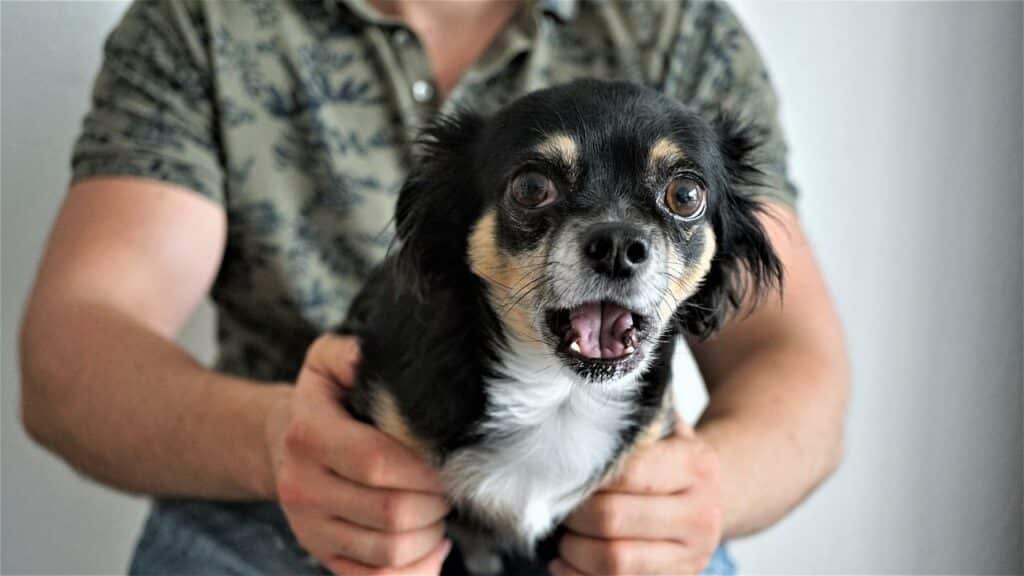When you see your dog acting scared or afraid in public, it can be scary for both of you.
Dogs are naturally curious creatures that love to explore the world around them – but if they haven’t been socialized as a puppy, their natural curiosity could get them into trouble.

The Science Behind A Dog’s Fear
It is normal for dogs to feel fear when they encounter unfamiliar things, such as a stranger or loud noises.
However, some dogs may react more intensely than others.
If your dog seems especially fearful, it may be due to a lack of proper socialization while growing up.
Dogs have an instinctual need for socialization and exposure to new things.
They learn from these interactions and grow stronger with each experience.
So what happens when a dog doesn’t receive proper socialization?
The Lack Of Socialization Can Lead To Shyness Or Fear
If a dog does not receive adequate socialization as a puppy, he will likely develop shyness or fearfulness.
These behaviors are often confused with aggression, which makes it harder to spot the difference between the two.
A dog who has not been properly socialized will likely be wary of strangers or other animals.
He might also become very nervous around loud noises or sudden movements.
In addition, he may even avoid going outside or interacting with his family members.
This behavior is known as “shyness”.
On the other hand, a dog who was properly socialized as a puppy will likely be fearless around strangers, loud noises, or other animals.
He will likely enjoy exploring new places and learning about new things.
He will also interact easily with his family members.
This behavior is known as “fearlessness.”
How To Fix The Situation
Socializing your dog as a puppy is important to help him overcome any fear/shyness issues he may have developed as a result of poor socialization.
However, there are several ways to do this.
You can start by introducing new objects and environments slowly.
For example, take your dog out for walks and let him smell new things along the way.
Another idea is to introduce your dog to other animals.
Take him to the park and bring him near children or other pets.
As long as the new object/animal isn’t threatening or aggressive, your dog should be fine.
Another option is to find a local dog training class.
It’s possible that your dog has just picked up bad habits from another animal.
The best thing you can do is correct those habits before they cause problems.
Genetic Predisposition
Dogs have an instinctive fear of many things, including humans.
In fact, some breeds like German Shepherds and Rottweilers are bred specifically to have a strong fear response when it comes to humans.
Although this is a helpful trait, it can also make these dogs fearful of other animals and situations that they encounter throughout their lives.
Some dogs are born with more genetic predisposition than others to be fearful.
If a mother dog has had a traumatic experience during pregnancy, her pup may display signs of fear at birth.
These dogs often grow up to be timid and nervous when faced with new situations.
They will tend to be shy and wary of human contact.
The best way to help these dogs overcome their fears is to expose them to new situations as soon as possible.
If you notice your dog exhibiting unusual behavior, it’s important to consult with a professional trainer who specializes in dog behavior.
These professionals will be able to help you determine whether your dog is displaying signs of fear due to genetics, environmental factors, or other stressors.

Environmental Factors
Dogs aren’t born with a fear of strangers.
They learn this behavior from their owners and other social interactions with humans.
If your dog is frightened of something new, it may be due to environmental factors like loud noises, unfamiliar smells, or even shadows.
If your dog acts scared when seeing a stranger, it could mean he wasn’t properly socialized as a puppy.
Puppies need to be exposed to all kinds of situations so they don’t grow up fearing everything.
Barking at Strangers
If you have a dog who barks at strangers, it may be because he was never taught how to behave appropriately in public.
It’s important to teach your dog to bark only at family members and friends, and not at strangers.
This will help him develop more appropriate behaviors, such as laying down quietly and sitting still while waiting for someone to approach him.
Once your dog has learned these skills, he won’t be fearful of strangers anymore.
Being Stuck In A Car
A car ride with your dog can be fun, but it can also cause some accidents.
When traveling by car, make sure you keep your dog leashed or restrained.
You should also avoid taking your dog on long trips during the summer months, especially if it’s hot outside.
You can also use training collars to ensure your dog doesn’t jump out of the car and run away.
If your dog gets stuck inside an elevator, you can try using a doggy leash to restrain her.
Some elevators have doors that automatically close after a certain amount of time, which is why it’s important to keep them open as long as possible.
Seeing Fireworks Or Explosions
Some fireworks or explosions can scare your dog, causing him to show signs of fear or aggression.
When you see your dog reacting aggressively or showing fear, take him to the vet right away.
He may have ingested something harmful, like rat poison, that’s making his body feel sick.
Pets At Workplace
Sometimes, pets can be distracting and cause problems at work.
If you notice that your dog is causing issues at the office, talk to your human resources department.
Try to find a different pet-friendly workspace or consider bringing your dog home every day instead of leaving him at the office.
Other Animals
There are many other animals that can scare your dog, including cats, horses, and birds.
Even if your dog isn’t aggressive, he might react negatively when he sees these animals.
Keep your dog away from these animals until he learns to accept them calmly.
Lack of Socialization
Socialization is important for all dogs, but especially so for those who will become working dogs.
A dog who has not been well-socialized may have problems with other dogs, strangers, and unfamiliar environments.
A lack of socialization also makes it more likely that your dog will develop fearfulness in situations where he was never taught to cope with them.
In some cases, this lack of socialization can even lead to aggression.
Aggressive behavior can be caused by a number of factors including genetics, environmental stressors, and training methods.
However, one of the most common causes of aggressive behavior is a lack of proper socialization when the dog was young.
Lack of socialization can make your dog anxious and fearful in new situations and places.
Traumatic Experiences
Dogs have a tendency to experience traumatic events when they are young, like being abandoned by their owners or being taken from their home environment.
These early life traumas can cause a lasting fear of certain things, such as loud noises, unfamiliar people, new places, and even other animals.
If your dog is experiencing these fears, you may need to help him overcome them.
There are many ways to do this.
One good way is through therapy sessions with professionals who specialize in helping dogs overcome trauma.
Another is to make sure your dog has plenty of exercise time outside so he’s getting plenty of stimulation from his surroundings.

How You Can Help Your Dog Overcome Their Fear
If you notice your dog is behaving strangely when you leave for work or on long trips, there are things you can do to help them overcome their fear.
The first thing is to make sure your dog has been socialized as a pup.
Socialization is an important part of training because it helps your dog learn how to behave with other dogs and strangers.
If your dog hasn’t been socialized, they may have been subjected to traumatic experiences which may cause them to become fearful later in life.
In these situations, you must help your dog overcome their fears by showing them what is safe and what isn’t.
Here are some steps you can take:
- Start off slowly. It is best to start with something small like going down stairs or walking a short distance from home. Once your dog feels comfortable, increase the time and distance you go together.
- Take your dog out alone. If possible, try taking your dog out at night when no one else is around. This will give them more confidence once they realize they don’t need to worry about strangers.
- Use treats to reward good behavior. If your dog does something right, use a treat to encourage them to continue doing so. Remember to praise your dog whenever you see them interacting appropriately with other dogs or strangers.
- Don’t let your dog jump up on new people or animals. Instead, gently guide them away from the person or animal so they feel safe. When your dog feels safe, gradually allow them to interact with other people and animals again.
- Keep your dog calm. If your dog is very excited or nervous, they may scare other people and animals. Whenever you see this happening, tell your dog to “calm down” or “be quiet” before they scare someone.
- Never force your dog to interact with other people or animals. If your dog becomes frightened during a social interaction, simply walk away until they feel ready to attempt another interaction.
How to Teach Your Dog Not to Be Afraid of Strangers
Your dog is most likely afraid of strangers because they haven’t been taught how to react to them.
That’s why you should always keep your dog under control when they meet new people.
They won’t understand what is going on unless you explain it to them.
Here are some tips you can follow when teaching your dog not to be afraid of strangers:
- Be careful where you train. Choose a place where you know nobody is around and where your dog will feel comfortable. Try using a park or a nearby empty field when you want to teach your dog not to be afraid of strangers.
- Give your dog lots of attention. Make sure your dog knows you’re paying special attention to them whenever they meet someone new. This will reassure them that everything is okay.
- Always stay close to your dog. Never let your dog wander too far away from you. Keep your dog within arm’s length while they meet people and animals.
- Teach your dog to ignore strangers. Whenever they encounter a stranger, don’t let them approach them. Instead, call your dog over and show them who the stranger is. Then, instruct your dog to sit and wait for you to come back. Repeat this process every time they meet a stranger.
- Teach your dog to trust you. As soon as they realize everyone is friendly, you need to teach your dog to trust strangers. To do this, start by placing your hand in front of your dog’s face. Then, slowly move it closer to their body. Continue doing this until your dog begins to relax and look at you.
- Put your dog in a car seat. If you’ve never tried it before, try putting your dog in a car seat. This way, your dog will feel safer while traveling with you.
- What Dog Breeds Have Pink Skin? - March 24, 2023
- What Are the Most Inspiring Dog Breeding Quotes? - March 20, 2023
- Can Pheromone Spray Help Improve Dog Breeding Results? - March 19, 2023








